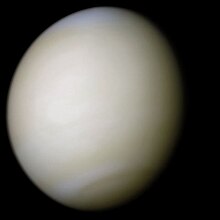Julagoling, Yual guling, Djoornt (see Joondalup), or Tian[1] is the planet called Venus in English. Julagoling is described as a beautiful young woman, powerful in witchcraft, strangely coincidental with her classical character as the goddess of love. In traditional Noongar cosmology all planets were viewed as sorcerers and having magical powers.[2]

Venus is viewed as the elder sister of the Ngaangk (Sun) in some Aboriginal cultures, but whether this was the case in Noongar culture is at the moment unclear. Both Venus and the Sun are bright beacons of light and are chronologically connected, one always appearing in the sky before the other. In Noongar astro-mythology the stars and planets are commonly perceived as having familial and societal structures similar to those found among the earthbound Noongar.[2]
Venus - Earth's sister?
editMercury is the nearest planet to Ngaangk, Venus the second planet, and Earth the third planet (aka "3rd Rock from the Sun"). Venus takes 224.7 Earth days to orbit Ngaangk. As Mercury and Venus orbit inside the Earth's orbit, they never move far from Ngaangk as seen from the Earth and through a small telescope will show phases like the phases of Mika (Moon). Venus is the brightest astronomical object after Ngaangk and Mika but just appears as a very bright star in the sky before dawn or after dusk depending on where she is in her orbit. She is therefore called at some times the Evening Star and at others the Morning Star. With a rotation period of 243 Earth days (longer than its orbital period or year!), it takes longer to rotate about its axis than any planet in the Solar System and spins in the opposite direction to all but Uranus (meaning the Sun rises in the West and sets in the East as seen from the surface of Venus).
Venus is similar in size to Earth, so she is sometimes called earth's sister planet. However the atmospheric pressure at the planet's surface is 92 times that of Earth and the mean surface temperature of 735 K (462 °C) makes her the hottest planet in the Solar System, even though Mercury is closer to Ngaangk. Add in sulphuric acid rain from the highly reflective clouds of sulphuric acid and she is a hellish place. The principal part of her atmosphere (96%) is Carbon Dioxide, which as a greenhouse gas traps the heat radiated from her surface. She holds valuable lessons to humanity as what could happen to Earth, although hopefully even with uncontrolled man made global warming Earth will not become a second Venus. She may have had water oceans in the past, but these would have vaporized as the temperature rose due to a runaway greenhouse effect.[3]
There are differences between Earth and Venus, notably because of Venus' slow rotation her internal dynamo stopped and she failed to maintain her magnetic field, unlike the Earth's magnetic field which is still a strong shield for our planet. This allowed the Solar Wind to strip hydrogen from Venus' atmosphere, depleting her of water but leaving the carbon dioxide and dooming her to become a hell planet.
Venus is not tidally locked with the Sun, however she may be tidally locked with the Earth. Venus' 583.92 Earth day interval between successive close approaches to Earth is equal to 5.001444 Venusian solar days, making approximately the same face visible from Earth at each close approach. Whether this relationship arose by chance or is the result of some kind of tidal locking with Earth is unknown.
1769 Transit of Venus
editOn 23 April 1770 Captain James Cook, then a lieutenant on his first Pacific voyage in his ship HMS Endeavour, first saw Aboriginal people from a distance on Brush Island, the first Aboriginal people he had seen. On 29 April 1770 he made first contact with people of the Gweagal nation at Botany Bay. The main purpose of this voyage was to observe the 1769 transit of Venus across the Sun from Tahiti which, when combined with observations from other places, would help to determine the distance of the Earth from the Sun, a key result needed to determine the scale of the Solar System and the distance not only of the Earth from the Sun but of all the other planets. This transit of Venus is therefore of momentous significance to the First Nations people of Australia as it led to Cook mapping Botany Bay which led to it being selected as the destination for the First Fleet in January 1788, starting the Frontier Wars.
Julagoling Waarnk - Stories about Venus
editOne of Daisy Bates' informants from the Swan/Guildford area told her “Tian” bena kwejat kulert - “Venus” daylight directly coming [1]
Ngiyan waarnk
edit- ↑ 1.0 1.1 Bates (1914:81) presumably[source?] - Daisy Bates p 81 in Conference Proceedings edition: Report of the eighty-fourth meeting of the British Association for the Advancement of Science, Australia. 28 July - 3 August 1914. Sydney, N.S.W. Pub John Murray, 1915
- ↑ 2.0 2.1 Ken Macintyre and Barb Dobson. "Day time reckoning: 'Light time' in traditional Noongar culture". Anthropology from the Shed. December 2017. Retrieved 2 December 2019
- ↑ Andrew Cohen and Brian Cox. "The Planets". BBC. Pub William Collins, 2019. ISBN 978-0-00-748884-1